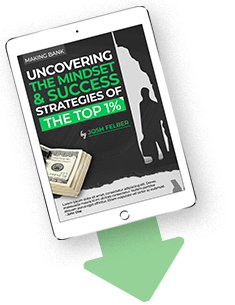10 Tricks for Writing Great Headlines
with Stefan Georgi
Video:
Audio:
with guest Stefan Georgi #MakingBank S4E30

So you’ve finished your article and you’re ready to hit that publish button, but one last nagging problem remains: writing a headline. Often the hardest part of an article to write, it can be tempting to just throw a generic descriptor up, but that is a big mistake.
Like it or not, your headline can make or break your article. The average headline will only entice about a quarter of the people who read it to click through to an article — and that’s if your headline is eye catching enough to even be read in the first place.
You need to face the reality: books are judged by covers, and it doesn’t matter how good your content is if no one reads it. Luckily, writing a good headline may be easier than you think, and there are even free tools you can use to analyze that quality of your wordcraft.
Here’s a list of 10 tricks you can use to break down headlines into the manageable, simple task they should be, and stop racking your brain for hours over this one single sentence.
- How-Tos and Listicles Get Clicks
You may like ’em, you may hate ’em, but list form articles get read. Letting readers know that you’re going to break down how to solve a problem in 3, 5, or 25 steps let’s them know what they’re getting themselves into and how much time it will take. Most importantly, these headlines draw in viewers.
One big advantage here: writing a listicle or a step-by-step how to can make the writing process much more simple. Instead of having to craft 2000 words, you can break it up into 5 chunks of 400, which is a much more manageable task. There’s a reason this article is broken down like this 😉.
2. Explain How You Can Improve Someone’s Life
A friend of the listicle: self improvement articles. Why are people reading your content anyway? We live in a world that loves self help. Everyone wants to improve in a multitude of ways, and using your experience or expertise to explain how others can achieve something meaningful is a great way to build a following.
The caveat: please… please… for the love of god. Only write this type of content if you have legitimate advice based on real life experience. Creating content that doesn’t genuinely help anyone will get nowhere and waste everyone’s time.
3. Use a Celebrity or Known Entity
“How Pink* Claims Meditation Improved Her Memory” gives readers something to relate to as well as instant credibility for the claim. This is much stronger than “How Meditation Improves Memory” or even “How Meditation Improved My Memory.” Pink is a known entity. You’re some person. Let her do the leg work.
*This is by no means real. Please do not use this actual headline.
4. Address Pain Points
If content is king, then content that solves your user’s problems is the entire empire. Draw the attention of your target audience with targeted statements that address pain points. “How I Automated Invoicing and Saved 2 Hours Per Week” tells everyone you’ve actually experienced the tedious task of invoicing, and you have a hack that can save a serious chunk of time.
Sharing your own experience with the pain point creates a connection with your audience and builds trust. Let them know that you understand what they’ve gone through because you’ve gone through it, and they will trust you to fix this problem.
5. Use a Timeframe
“How to Lose Weight in 2020” is generic and boring. “How to Lose 5 Pounds in One Month While Eating Your Favorite Foods” gives people a specific timeframe, indicating you have a plan, as well as experience leading or using it yourself. This is a much more promising headline and gives readers a reason to click.
Caveat: don’t overpromise. If you deliver on your goods, you will build a loyal following. If you don’t, you will be banished to irrelevancy in no time.
6. Use Coschedule’s or Sharethrough’s Headline Analyzers
Both Coschedule and Sharethrough offer free headline analyzers on their websites that will grade your headline as well as provide statistics and advice on how you can improve it. They mention many of the concepts covered in this article, and many more. When it comes to crafting headlines that catch eyes and earn clicks, there’s no better tool than what these industry experts offer.
Coschedule focuses on blog articles or content while Sharethrough is geared towards ads, but much of their advice is the same.

7. Open Up About A Personal Topic
There’s a reason that doing scary things pays off: most people are too scared to do them. If you are willing to tread on ground that others won’t you gain some street cred. Doing so takes courage, and your content will be more unique and more valuable. Sensitive subjects can be a big draw if well crafted, and you can earn a lot of respect this way.
That doesn’t mean you need to overshare, or make every piece of content deeply personal. Open up when you’re ready, and when you feel you can make sense of your past trauma, illness, breakup, or whatever else. The advice you give here can reach much deeper into your audience’s collective souls, and if done well this will create a devoted following.
8. Be Realistic
People can sniff out a lie. If you’re promising something unrealistic, people will laugh you off as a snake oil salesman and move on. On the other hand, stating something realistic, or even erring on the underside, sounds more achievable and makes you look more genuine.
Telling someone you can help them save $6,000 in the next 2 months is pointless, but offering to help people save $3 a day? Realistic, achievable, and amounts to a big difference over the course of a full year.
9. Use Your Audience’s Lingo
Speaking in language your audience uses is a huge advantage, especially if it’s slang. In this episode of the podcast, Stefan Georgi recommends seeking out user forums and product reviews to find out how your audience speaks and mimicking that back to them. Stefan noticed that gun enthusiasts abbreviated “The Second Amendment” to simply “2-A.” Using that abbreviation helped Stefan stand out to his audience and build credibility, translating into more clicks and more conversions.
10. The Emotional Game
Playing the emotional game is a slippery slope, but when done well it is one of the best tricks to have in your back pocket. The key, according to Coschedule, is either not to go overboard… or go WAY overboard.
Employing one key positive or negative word in your headline (‘doubt,’ ‘risk,’ ‘hottest,’ ‘funniest’), helps spark interest, as does going overboard with a bunch of words packed in. Its the middle ground you want to avoid.
Pro-tip: the negative words actually evoke a stronger reaction, but be careful here, because evoking fear too much can cast your brand in a bad light and wear people down.
What’s left unsaid? While a good article will go underappreciated if it doesn’t have a good headline, a great headline connected to a terrible article will just annoy your users and make them distrust you. You need to walk the fine line between grabbing people’s attention, and actually creating legitimate content to take advantage of it. If you can finagle that, you can find yourself quitting your day job and working with a margarita in hand before you know it.
Topics
- Accelerated Learning
- Artificial Intelligence
- Become Present
- Blockchain
- Branding
- Business
- Education
- Entrepreneurship
- Family
- Finance
- Health
- Health & Wellness
- Internet Marketing
- Investing
- Leadership
- Lifecoach
- Marketing
- Negotiation
- Performance
- Productivity
- Publicity
- Real Estate
- Sales
- Sales Success Habits
- Video Marketing
- Writing















